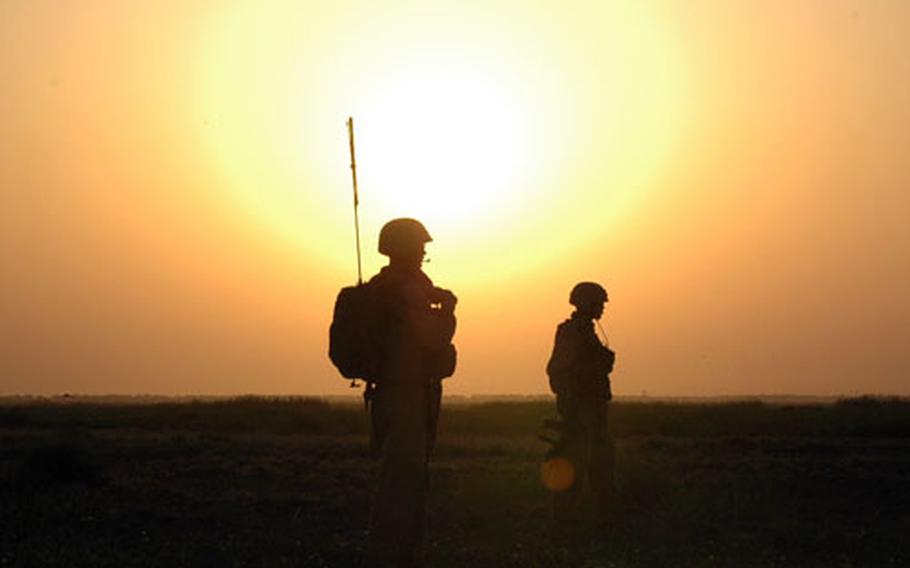
Marines with the 1st Combat Engineering Battalion prepare to search farmlands south of Fallujah for hidden weapons caches at dawn Sunday. (Monte Morin / Stars and Stripes)
CAMP BAHARIA, Iraq — The hostages sat shackled in a cinder-block cavity beneath the desert floor.
In the wastelands above them, their captors built car bombs and stockpiled weapons in the parched wadies and thorn bushes south of Fallujah.
For weeks, the three prisoners — abducted Iraqi government workers — were left to sweat their fate in the cramped and fetid spider hole.
On Sunday, however, the hostages’ freedom came suddenly and unexpectedly when a platoon of Marines from the 1st Battalion, 25th Marine Regiment swept over the insurgent lair, captured three dozing guards and tore open a trap door to the cell.
“These guys were pretty happy to see us,” said Marine Capt. Brendan Fogerty, 30, commander of 1st Platoon, Weapons Company. “They told us they had been down there for a month.”
The dramatic dawn rescue was the highlight of a massive, three-day operation aimed at rooting out insurgent cells and weapons stockpiles in the agricultural towns and desert flatlands south of Fallujah. Operation Spotlight, as it’s called, involved three Marine companies and several Iraqi Army squads who detained roughly half a dozen suspected insurgents and unearthed numerous weapons caches.
On Sunday, four enormous explosions thundered across the desert as engineers and bomb experts detonated a car bomb and scores of mortar rounds, rocket propelled grenades, artillery shells, machine guns, anti-personnel mines and bomb-building materials.
“It’s like stealing candy from a baby today,” said 1st Lt. Christopher Doggett, 25, as engineers from the 1st Combat Engineer Battalion pulled all manner of ordnance from desert scrub bushes and patches of reeds along canal beds. “We’re taking all their weapons away.”
The operation follows a period of stepped-up insurgent activity in the area, according to regimental commanders.
“The 3rd Battalion, 5th Marine Regiment used to live here, but they’ve moved,” said Capt. Mark Maracle, assistant operations officer for the 1-25. “Since then, we think the insurgents have been using this area as a staging point for their operations in places like Ramadi, Fallujah and maybe Baghdad. We know they’ve used it to set up kidnappings and harass the public.”
Marines have observed some insurgent activities by remote- controlled aircraft, including a suspected kidnapping. In that incident, the unmanned aircraft recorded insurgents placing a suspected hostage in a car and then followed the car to the hidden spider hole.
“Six guys went into the bunker and five guys came out,” Maracle said several hours before the spider hole was raided by Marines. “Either he’s a captive down there or he’s dead.”
Scores of vehicles, including Humvees, seven-ton troop transports and specialized mine clearing trucks, set out for three specific targets in the early morning hours Sunday.
Prior to the operation’s kickoff, word had leaked out that Marines were planning to hit the area, and troops braced themselves for encounters with roadside bombs.
“One of our concerns is that operational security has been violated somehow,” Maracle said shortly before the vehicles rolled. “Our intelligence reports that the insurgents know we’re coming. What they don’t know is how many and when. They’ve been building berms and have been putting rocks on the road. Historically, the IEDs here have been a lot more devastating.”
While one portion of the force rolled to sites in a small agricultural town south of Fallujah, another element moved further south to the desert. It was just before dawn, around 5 a.m., when Fogerty’s platoon, a scout sniper team and military dog handlers crept on foot to the spider hole.
“We’d never been here before, so we really didn’t know what to expect,” said Fogerty, a native of South Boston. “Right away we start finding mortar rounds and artillery shells.”
Aerial surveillance reported that there were three insurgents in the area of the target. Marines found the first one asleep about 100 yards from the hiding place. The other two were fast asleep on top of the bunker.
The Marines and dog handlers were on them in an instant.
“They did not see it coming at all,” Fogerty said.
Suddenly, the Marines heard voices coming from small air vents beneath the ground.
“They were yelling, ‘Help us! Help us!’” Fogerty said.
Marines crawled through a plywood trap door, down a narrow cinderblock corridor and into a wider chamber strewn with blankets, coolers, water jugs, a teapot and an electric fan attached to the wall. The haggard hostages were found shackled behind a metal grating.
Throughout the area, insurgents had dug trenches in which they had hidden weapons, stoves, teapots and other items.
“Wherever you went, you just pulled up a rag and there would be something underneath,” Fogerty said. “We even found a 10-foot rocket.”
None of the insurgents who were captured Sunday put up a fight, although two mortars were launched at Marines much later in the day as they piled weapons for detonation at the spider hole site. The rounds fell wide of the mark and were answered by booms of counter-battery fire.
The only Marine injuries that occurred during the operation Sunday involved the crewmembers of a Humvee that had flipped into a canal while driving along the treacherous dikes that separate the muddy canals from area farmland. The men were evacuated by helicopter.
Commanders said they were very pleased with the amount of weapons they had discovered, but were even happier that they got to the hostages when they were still alive.
“It’s exciting for us,” said Maj. Chris Graves, of Headquarters and Support Company. “The hostages are the most important thing … Usually the outcome for someone getting kidnapped like that is not very good.”